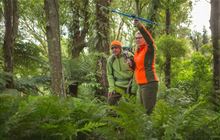Marine inventory and monitoring
Introduction
This module describes methods to inventory and monitor marine species and habitats.How to use this module
- Consult the introduction and the comparative tables and decision trees to help you select the method(s) most appropriate for your study.
- Be aware of the minimum data collection standards for methods.
- Read the DOC Marine Monitoring and Reporting Framework (MMRF) for guidance on implementing long-term marine monitoring within the national marine reporting system.
Introduction
How to decide the best method for marine monitoring (PDF, 357K)
Read this short introduction about monitoring marine ecosystems and species. Then consult the decision trees and comparative tables to help decide the most appropriate method(s) for your project.
Decision tree (PDF, 529K)
The decision tree is a tool that will assist you in choosing the method(s) most suited for your study. Use the trees in conjunction with the comparative tables.
Comparative tables (PDF, 882K)
The comparative tables can help you choose the most appropriate method(s) for your study. Use them in conjunction with the decision tree.
Introduction to marine summary ecological statistics (PDF, 1,736K)
This document describes common ecological marine measures and how to calculate summary marine ecological statistics. It also has advice on presenting ecological data, which analyses to use and the summary statistics to present.
Method description
Fish
Baited underwater video surveys for fish (PDF, 3,670K)
Baited underwater video is an unobtrusive sampling method which is effective in providing size and abundance estimates of scavenger and carnivorous reef-fish species that can be difficult to survey using divers.
Underwater transects for sampling reef fishes (PDF, 2,492K)
This method measures the abundance, size, and species composition of reef fishes within a set volume (a transect) by swimming inside it. It is most suitable for the monitoring of medium to large species known to be observable by divers.
Invertebrates and macroalgae
Quadrats for invertebrate and macroalgal communities (PDF, 1,154K)
Quadrat sampling is a classic tool for ecological study allowing the characterization of sessile invertebrate communities (eg species relative abundance, richness, diversity) or to describe the populations (eg density, size structure, sex ratio) of mobile invertebrates and associated macroalgal communities.
Transects for mobile invertebrates (PDF, 1,123K)
Mobile invertebrates are well-recognised and important part of rock reef fauna. The monitoring method focuses on describing populations (eg density, size structure, sex ratio) of three common mobile invertebrates although it can also be applied to a broader suit of species.
Potting for lobster (PDF, 2,900K)
This method measures the relative abundance and population structure of lobsters by setting out baited pots overnight to catch lobsters.
Infauna
Soft sediment sampling for infaunal communities (PDF, 1,241K)
Soft sediment cores are used to measure population (eg density) and/or community metrics (ege relative species abundance, richness or diversity) of soft sediment infaunal assemblages within estuarine sand/mudflats. They can give a good indication of the health and ecological condition of soft sediment environments.
Habitat
Functional trait surveys for benthic organisms (PDF, 1,584K))
This method evaluates the biological traits of benthic organisms which are related to the functioning of communities or ecosystems to produce a matrix of functional trait diversity.
Water quality
Secchi disk monitoring of water clarity (PDF, 601K)
Secchi depth provides an in-situ measure of water clarity. It is commonly recorded in many marine field studies as suspended sediment is often an important environmental covariate.
Marine: sampling of water and sediment chemistry (PDF, 2,133K)
Sampling chemical properties in sediment and water is used to measure and understand the condition of the environment, and enables managers to examine changes in condition and ascertain risks to estuarine and coastal habitats. This method describes the field collection and appropriate storage and transport for post-laboratory processing of water and sediment samples.

